
Any roast or other large piece of meat is better when it's cooked evenly from all sides, avoiding a mixture of overcooked and undercooked places. It's even beneficial for pre-cooked meats, such as a boneless ham. That's why spit-cooking on a rotisserie remains popular. You can cook your ham outdoors on a grill or indoors in an oven using the same basic technique.
On a Grill
Step 1
Attach the rotisserie motor to your grill. Set up and light your coals, adjusting the vents and draft to achieve a temperature of 325 to 350 degrees Fahrenheit. If you have a gas grill, preheat it to the same temperature.
Step 2
Trim any excess surface fat from the ham, leaving 1/4 inch to protect the meat from drying out. Score the fat lightly with a sharp knife, to help it render in the heat. Pat the ham dry with clean paper towels.
Step 3
Skewer the ham from end to end with the spit, then slide the secondary forks or prongs into place to keep the ham stationary. Rotate the spit a few times by hand, to test its balance. If necessary, remove the spit and re-insert it.
Step 4
Open the grill and lift your spit into place. Place a pan under the ham to catch drips as the fat renders out, preventing flare-ups that can give your ham harsh, burnt flavors. Close the lid, and start the motor.
Step 5
Cook for approximately 9 to 10 minutes per pound, or until the ham reaches an internal temperature of 140 F when tested with an instant-read thermometer. If you wish to glaze your ham, brush on the glaze 30 minutes before the end of your expected cooking time.
Step 6
Let the ham rest for at least 10 minutes before carving.
In an Oven
Step 1
Preheat your oven to 325 F. While it's heating, trim all but 1/4-inch of surface fat from the ham. Leaving that much in place protects the ham from drying as it cooks.
Step 2
Slide the ham onto the main spit, aiming for the ham's center of gravity. Slide the supporting prongs or forks into place, then test how well-balanced the ham is by rotating the spit by hand. If it's badly unbalanced, remove the spit and try again.
Step 3
Place the rotisserie unit in the oven, locking it into place. Slide an empty pan underneath to catch drippings, then close the oven door and start the rotisserie motor.
Step 4
Bake the ham for 9 to 10 minutes per pound, or until its internal temperature reaches 140 F when tested with an instant-read thermometer.
Related Articles
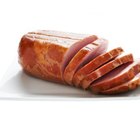
How to Cook a Boneless Ham on a ...
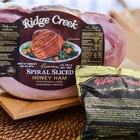
Cooking Instructions for a Ridge Creek ...

How to Fully Cook a Hickory Smoked Ham

How to Carve a Spiral Cut Ham

How Do I Roast a Picnic Ham?

How to Reheat a Ham

How to Smoke a Ham Shank on a Charcoal ...

How to Cook Prime Rib Using an Oven ...

Instructions for Baking a Smoked Ham ...
How to Cook a Standing Rib Roast on a ...

How to Boil Cabbage and Ham
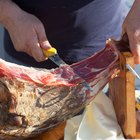
How to Cook a Ham: Removing the Skin
How Do I Cook a Black Forest Ham in a ...
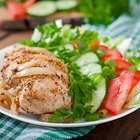
How to Cook Chicken Breasts in a ...
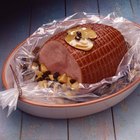
How to Cook a Daisy Ham

How Long to Cook a Suckling Pig on a ...

Shank Ham Cooking Directions
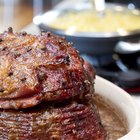
How to Bake a Smithfield Spiral Ham

How to Julienne Ham

How Many Calories Are in Smoked Ham?
References
- Recipe Tips: Rotisserie Grilling
- The Ultimate Rotisserie Cookbook: 300 Mouthwatering Recipes for Making the Most of Your Rotisserie Oven; Diane Phillips
- USDA Food Safety and Inspection Service: Ham and Food Safety
Warnings
- Pre-cooked hams are considered food safe at 140 F, as long as they are purchased in the processor's original packaging. If your ham has been re-packaged or deboned at the butcher's shop, it should be cooked to an internal temperature of 160 F instead. This requires an additional 2 to 4 minutes per pound.
- Roasting unbalanced meats on a rotisserie can cause the motor to burn out, especially in lower-cost units. Be diligent about balancing the ham to the best of your ability.
- When loading the ham into your oven or grill, exercise caution to avoid burning yourself on the preheated surfaces.
Writer Bio
Fred Decker is a trained chef and prolific freelance writer. In previous careers, he sold insurance and mutual funds, and was a longtime retailer. He was educated at Memorial University of Newfoundland and the Northern Alberta Institute of Technology. His articles have appeared on numerous home and garden sites including GoneOutdoors, TheNest and eHow.
Photo Credits
Ablestock.com/AbleStock.com/Getty Images